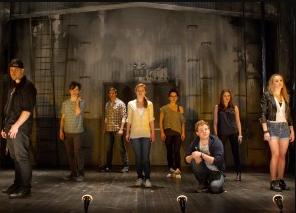Translate Page
Before it even begins, the musical Carrie emanates dread. The set of MCC's revival, now at the Lucille Lortel, suggests an empty, decrepit theatre. There are stains on the walls and floor, and climbing rungs on the back wall recall an escape path from a sewer. But there's obviously life in the darkness: Nooks and crannies are filled with flickering candles, suggesting someone was there to light them and will return to snuff them out.
The eeriness jibes with Stephen King's novel. Carrie follows the story of a teenage girl who's been so sheltered by her religious fanatic mother that she doesn't understand what's happening when she begins her first menstrual cycle. Her naiveté invites merciless bullying at school, and she might be a classic victim if puberty hadn't also awakened her telekinetic powers. When her classmates shame her at prom by dousing her with pig's blood, her rage has supernatural consequences.
Set designer David Zinn wanted to embody those consequences---to evoke the emotional state of furious alienation. "We wanted [the set] to reflect a mood," he says. "In some stories, the details of the locations are very important, but Carrie is not one of those stories. It puts the focus on the group, on the kids. It's the kids versus Carrie, and that doesn't need a diner counter and a ketchup holder and a school desk."
The entire production follows this line of thought: Carefully avoiding the campiness that made the musical's 1988 Broadway run such a notorious flop, the revival, which reunites the original writers, focuses on the social and spiritual dynamics that create Carrie's fate. The story may not be real, but it's intended to feel authentic. While Zinn's design creates an authenticity of mood, Emily Rebholz's costumes aim for more literal realism. The high school characters look like a typical group of kids, and even Carrie's long skirts and bulky sweaters are the believable wardrobe of an awkward girl. Many of the costumes, in fact, came from retail stores.

But even though she bought clothes off a rack, Rebholz still had to design Carrie's world. Take Sue Snell, the good-hearted teen who feels bad for tormenting Carrie and manages to survive her rampage. The show is framed as a flashback while she tells her story to local police, which means she also has to gain our trust as a narrator. "She really did need to be relatable, so I was always trying to go with the simplest look for her," says Rebholz. "She needs to look cute and nice, and maybe she shops at Forever 21, but you don't want to look at her and think, 'Oh my gosh, that's the popular girl that used to torment me in high school.'"
And there's a subtler story in Sue's mall-wear. For instance, she's the only character who wears yellow. "We found that the actress [Christy Altomare] looked really pretty in yellow, but also in a spotlight, in yellow she was really pulled out [and prominent,]" says Rebholz. "All the other clothes were designed around leaving yellow for her and her ability to pop."
The other costumes also remind us that Sue's telling this story from memory. Rebholz explains, "When we start, all the kids are in these grey colors. It's like her memory becomes clearer. It starts off as her memory of this herd, of this herd mentality, and we're not so much in specificity of character. As they become individuals, they pop into color." Most actors have two versions of the same costume, one in muted tones and one in bold colors. The only exception is Carrie, whom Rebholz assumed that Sue would vividly remember.
And Carrie's costumes, of course, reveal things about her character. Her pale pink prom gown is simple and floor-length, sleeveless with two straps. It's a marked contrast from the other girls' mini-skirts. "She gets her moment [at the prom], and she's beautiful and happy, but we didn't want to make it suddenly like she fits in," Rebholz says. "It's just that she's confident and feels beautiful, and that makes what happens even more heartbreaking."
--
Mark Blankenship is TDF's online content editor
Photos by Joan Marcus